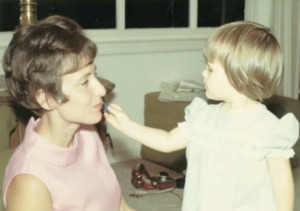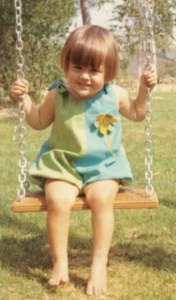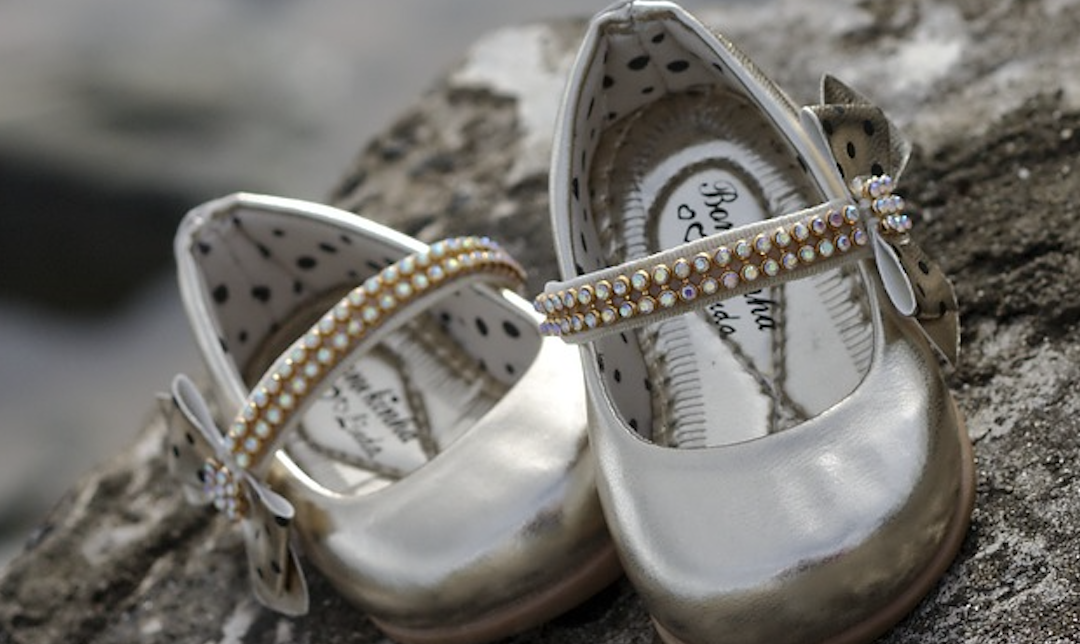Trapped in Time
First published in WNC Woman Magazine Mother’s Day Issue
Have you ever listened—really listened—to the stories your mother tells about you? They can seem to trap you in time. Like the story my mother often told about me as a toddler who slipped away in a store, walked up to a woman in sandals, pointed to her toes, and said “wee-wee.” An event that made perfect sense as a toddler schooled in the Three Little Pigs toe game, but from the way my mother told it, a moment of sheer mortification frozen in her memory. A mother’s stories lock you in time because those early tales help create your early identity. And the stories you learn to tell from that identity can imprison you forever—or set you free. It is, after all, our stories that ultimately define us and also confine us.
 One of the earliest stories that shaped me was less of a tale and more of a continuing narrative that expanded throughout my early life. You probably had one, too. I grew up in a fairly conservative (for Southern California), Baptist family and was trained from birth to be a shining jewel that radiated that story. Had I been the “blank slate” that was the working model of a child at the time, that might have turned out splendidly? But we each come pre-wired to a certain extent and that wiring can take perfectly good training and reroute it into an unintended plotline.
One of the earliest stories that shaped me was less of a tale and more of a continuing narrative that expanded throughout my early life. You probably had one, too. I grew up in a fairly conservative (for Southern California), Baptist family and was trained from birth to be a shining jewel that radiated that story. Had I been the “blank slate” that was the working model of a child at the time, that might have turned out splendidly? But we each come pre-wired to a certain extent and that wiring can take perfectly good training and reroute it into an unintended plotline.
What I took from that early narrative was that there was an accepted way to be, and from that expectation, I fashioned a straightjacket to contort myself into a satisfactory pose, not unlike the little straightjacket I was buckled into as a toddler to hold me still so the doctor could stitch up a gash in my head from rolling off a chair and slicing my forehead open with the heel of my patent leather shoe. That’s another story about me that I don’t recall, but that left a still identifiable scar. I don’t think the metaphorical straightjacket was what was intended, but the lessons parents try to impart and the lessons learned are rarely the same.
Crafting this sort of straightjacket sews into place layers of default choices in the psyche that steer our lives from deep within. The first stratum forms from internalizing what is acceptable in your particular family dynamic (what it is to be a good girl or bad girl in your house, and which one you were expected to be.) The second layer is an autopilot rebellion against those same expectations (fighting back to claim your individuality.) Your particular balance of conformity and rebellion depends on things like your unique pre-wiring, who came before you in the sibling line-up and the kind of road they paved, how your parents react to their own default choice strata, your school environment and an endless list of influences that make up the many hidden layers of perceived identity.
A lot of people never break out the boomerang effect of re-enacting what is acceptable and reacting against it. They live out a disjointed jig of security and freedom, two needs that underlie identity and compel each of us to strike out on our own hero’s journey or to shy away from it. Even in this age—perhaps, especially in this age—of information overload, no matter how original you think you are thinking, your thoughts travel via the wiring of those early patterns. To make a more authentic choice you have to create a new story, not just a revision of the one you were born into, but a story that springs into your life as a fully-formed challenge, stokes a part of you to life that you didn’t realize was there, and tumbles the familiar over a cliff to flounder in a choppy sea.
This brand of confrontation often comes via hardship, a divorce, a death, or some other life-altering trauma. But sometimes it comes more gently, like via a mother’s story.
It was somewhere in my mid-to-late teens when the LA Times ran a story about a journalist who had recently died, revealing that the journalist who had lived life as a man, had been born a woman. They did this so well and for so long that no one but their immediate family knew they weren’t a man until after their death. This, my mom said, was something she could see me doing, thumbing the system to pursue a passion or an ideal no matter what the cost.
 It truly shocked me. Had she not seen how hard I’d tried to fit into the straightjacket, at least on the surface? Was I poking out at the seams? Was she exhibiting one of those parental spidey-senses that intuited something that I’d tried ever so hard to hide? Was this a test of some sort? I was instantly suspicious. To this day don’t remember how I responded at the moment, but somewhere inside a wall crumbled with that remark. Not only did she see that certain rules were made to be broken (how much more fun might life have been if I’d known that?!?), but she thought that I was the kind of person who would go around breaking them. It was more than permission to burn the rulebook (which was probably not what she had intended); it was a fully formed challenge for me to step into, which I did, bit by bit.
It truly shocked me. Had she not seen how hard I’d tried to fit into the straightjacket, at least on the surface? Was I poking out at the seams? Was she exhibiting one of those parental spidey-senses that intuited something that I’d tried ever so hard to hide? Was this a test of some sort? I was instantly suspicious. To this day don’t remember how I responded at the moment, but somewhere inside a wall crumbled with that remark. Not only did she see that certain rules were made to be broken (how much more fun might life have been if I’d known that?!?), but she thought that I was the kind of person who would go around breaking them. It was more than permission to burn the rulebook (which was probably not what she had intended); it was a fully formed challenge for me to step into, which I did, bit by bit.
I started listening more closely to her and other people’s stories from then on, for clues to my own story that I didn’t acknowledge—or didn’t see. It’s hard to see the story you are living when you are living it, and it is nearly impossible to step out of the story you are telling yourself, the one that is invisibly shaping your life until something challenges the story and allows you to create a new one.
The big lesson is that you get to choose the story you live, and the real coursework of this lesson is to choose your story before your story chooses you. We’ve all seen people who imprison themselves with the limits they hold themselves to, who tell themselves and the world a story that says that they are constricted by their education, their gender, their relationships. And we’ve all thought, “if she only just…” But the storyteller is, strangely, the last to consider a new plotline, especially when she thinks she has only one story to tell.
How many stories do you have to choose from? If you look at your mother’s stories, your father’s, siblings’, friend’s, teacher’s, children’s, co-workers’ and more, I bet you have hundreds. A good one to start with is your mother’s though, since she was probably the one paying the most attention to the younger you. If you tell yourself the story of your life through her perspective, what do you find out about yourself that you hadn’t considered before? What might you want to splice into—or out of—the story you tell about yourself? Do the same with all the significant people in your life, and see what you learn about yourself. Then retell your story of yourself to yourself, embellishing the yummy parts with each telling to expand into some delicious challenge that you may not have considered. Through your new story, see how you can set yourself free from some old plotline that no longer serves you.
 Then consider the story you tell yourself about your mother. Chances are that the identity you cloak your mother in is trapped in the same era as her early stories about you, and for the same reasons. Early wiring traps you in the perception of parents as the people whose approval you need to go out to play or eat dessert. But mothers evolve, too, and maybe there is a story or two that you can use to update your vintage image of her. Think of it as a gift to her in honor of Mother’s Day, as well as a gift to you.
Then consider the story you tell yourself about your mother. Chances are that the identity you cloak your mother in is trapped in the same era as her early stories about you, and for the same reasons. Early wiring traps you in the perception of parents as the people whose approval you need to go out to play or eat dessert. But mothers evolve, too, and maybe there is a story or two that you can use to update your vintage image of her. Think of it as a gift to her in honor of Mother’s Day, as well as a gift to you.
One of my favorite mother-evolution updates is overlaying a picture I have of my mom as a bouffanted, white-gloved Sunday School teacher with a more recent story about the same woman, newly freed into her post-retirement second childhood. When traveling with friends, they found a five-foot-long plastic blow-up shark, inflated it, and took it everywhere with them on their vacation—getting it a seat at restaurants, buckling it into the car, taking it sightseeing, and introducing it around as their chaperon. You can see how this fresh image might fritz-out the old picture of the caring, conscientious mother who set my bedtime (unfairly) before the Brady Bunch came on and put only healthy, hard-to-trade food in my school lunch. Not only is it more accurate to the person she is now, it’s much more fun. And it makes it hard to believe that, after having a giant blow-up shark as her travel date, she’d ever again be embarrassed by a child who said “wee wee” to a strange woman’s toes.
Let’s Get Social

About Kristine
Pushing the edges of my consciousness has been my passion for as long as I can remember. This has flowed me into writing, podcasting, and becoming a hypnotherapist to help others push past limiting perceptions and expand their awareness and possibilities, too. Welcome to my world. Thanks for visiting!

